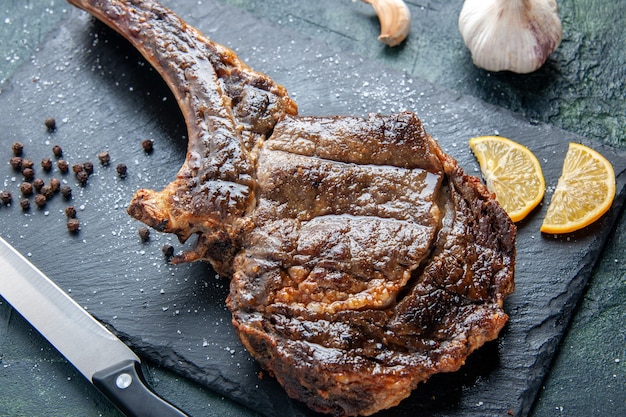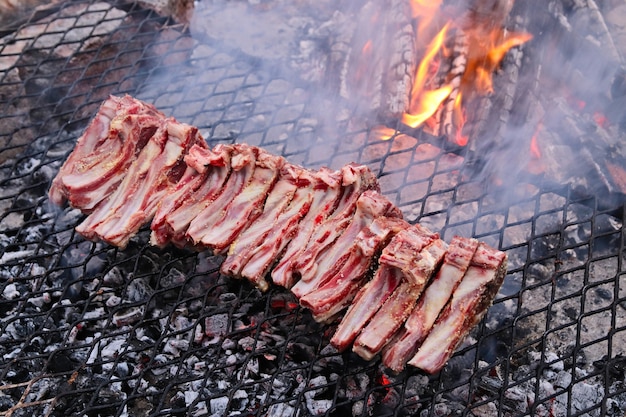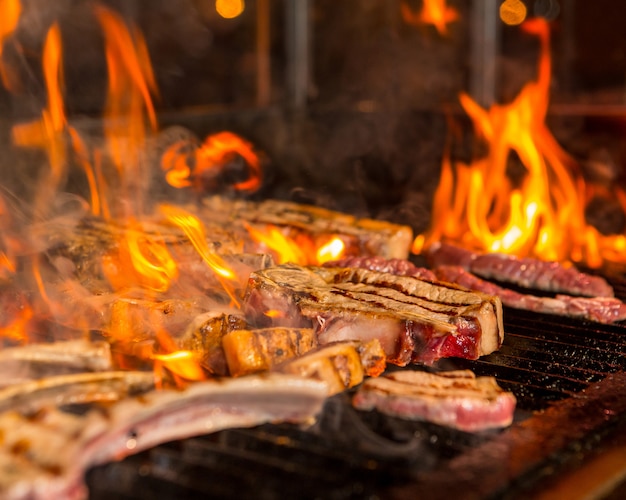What does cooking ribs in foil do?
Cooking ribs in foil is a popular method used to achieve tender and flavorful meat. By wrapping the ribs tightly in aluminum foil before cooking, you create a controlled cooking environment that helps to lock in moisture and infuse the meat with delicious flavors.
The Benefits of Cooking Ribs in Foil
When cooking ribs in foil, several benefits come into play:
- Tenderizes the Meat: Wrapping the ribs in foil helps to retain moisture during the cooking process, resulting in tender and juicy meat. The sealed foil packet acts as a barrier, preventing the ribs from drying out.
- Enhances Flavor: Cooking ribs in foil allows the meat to marinate in its own juices, as well as any additional seasonings or marinades. This leads to a deeper and more intense flavor profile.
- Reduces Cooking Time: By trapping heat and steam, cooking ribs in foil can help to reduce the overall cooking time. The enclosed environment created by the foil helps to speed up the cooking process and ensures even heat distribution.
The Foil-Wrapping Technique
To cook ribs in foil, follow these simple steps:
- Preparation: Start by seasoning your ribs with your preferred dry rub or marinade. Make sure to remove the membrane from the bone side of the ribs for optimal tenderness.
- Wrap in Foil: Tear off a piece of aluminum foil large enough to completely enclose the ribs. Place the seasoned ribs in the center of the foil and tightly wrap it around the meat, sealing the edges to create a secure packet.
- Cooking Method: There are different cooking methods to choose from when using foil-wrapped ribs. You can bake them in the oven, grill them, or even cook them in a slow cooker. The time and temperature will vary depending on your chosen method.
- Finish on the Grill (Optional): If you prefer a caramelized and slightly crispy exterior, you can unwrap the foil packet and finish the ribs on a hot grill for a few minutes. This step adds a delicious smoky flavor and a nice texture to the meat.
“Cooking ribs in foil not only helps to tenderize the meat but also keeps it moist and full of flavor. The foil acts as a protective barrier, creating a perfect cooking environment for juicy and succulent ribs.”
Should I wrap my ribs in foil for BBQ?
One of the most debated topics among BBQ enthusiasts is whether or not to wrap ribs in foil during the cooking process. This technique, known as the “Texas crutch,” involves wrapping the ribs in aluminum foil after a period of smoking to help tenderize them and retain moisture. While some swear by this method, others prefer to let their ribs cook unwrapped for a more traditional texture and flavor.
Pros of wrapping ribs in foil
Wrapping ribs in foil can have several benefits. Firstly, it helps speed up the cooking process by creating a mini-oven effect, trapping heat and moisture around the ribs. This can result in more tender and juicy meat. Additionally, wrapping the ribs can prevent them from drying out, especially during longer cooking times.
“Wrapping your ribs in foil can help you achieve fall-off-the-bone tenderness and a moist texture.”
Another advantage of using foil is that it allows for the addition of flavorful liquids, such as apple juice or barbecue sauce, which can infuse into the meat during the cooking process. This can enhance the taste and create a delicious glaze on the ribs.
Cons of wrapping ribs in foil
While wrapping ribs in foil may have its advantages, there are also arguments against this technique. One common concern is that the wrapped ribs may lose some of the desirable smoky flavors that come from cooking uncovered. The foil can create a barrier between the meat and the smoke, resulting in a milder flavor profile.
Moreover, wrapping ribs can lead to softer, fall-off-the-bone texture, which may not be preferred by everyone. Some BBQ purists argue that ribs should have a slight chew and resistance, allowing you to appreciate the meat’s natural texture.
Do you put ribs meat side up or down in foil?
When it comes to cooking ribs, there is often a debate about whether to place the meat side up or down in foil. The answer largely depends on personal preference and the desired outcome of the ribs.
Meat Side Up: Placing the ribs meat side up in foil allows for better basting and caramelization of the meat. This method can result in a slightly crispier exterior and more flavorful ribs. The juices released from the meat will be captured in the foil, creating a moist cooking environment.
Meat Side Down: Alternatively, some prefer to place the ribs meat side down in foil. This helps to protect the meat from direct heat, resulting in a more tender texture. It also allows the fat to render slowly, ensuring a juicy and succulent finished product.
The 3-2-1 method:
One popular technique for cooking ribs is the 3-2-1 method. This method involves three stages: three hours of smoking directly on the grill, two hours wrapped in foil with added liquid for moisture, and one hour back on the grill to finish and glaze the ribs.
“No matter which way you choose, remember that the quality of your ribs will depend on factors such as temperature control, cooking time, and seasoning.”
To help you decide which way to position your ribs, consider the following factors:
- Flavor: If you prefer a more intense flavor and crispy exterior, try placing the meat side up.
- Tenderness: If tenderness is your priority, placing the meat side down may yield more desirable results.
- Juiciness: Both methods can result in juicy ribs, but placing the meat side down may help retain more moisture.
Ultimately, the choice between meat side up or down in foil is up to you. Experiment with different techniques to find the method that produces the most delicious ribs for your taste. Happy cooking!
What do you put on ribs before wrapping in foil?
When it comes to cooking ribs, one popular technique is to wrap them in foil during the final stage of cooking. This helps to seal in moisture and create tender, fall-off-the-bone ribs. But what should you put on the ribs before wrapping them in foil? Let’s explore some options that will take your ribs to the next level.
1. Dry Rub
A dry rub is a mixture of spices, herbs, and seasonings that is applied to the ribs before they are cooked. It adds flavor and enhances the crust that forms on the outside of the meat. A classic dry rub for ribs might include ingredients like brown sugar, paprika, garlic powder, onion powder, salt, and pepper. Apply the dry rub generously to both sides of the ribs before wrapping them in foil.
2. Barbecue Sauce
If you prefer saucy ribs, consider slathering them with barbecue sauce before wrapping them in foil. Choose a sauce that complements the flavors of the rub you used or go for a traditional tomato-based barbecue sauce. The sauce will caramelize as the ribs cook, adding a tangy and sweet glaze to the exterior.
3. Apple Juice or Cider Vinegar
To add moisture and enhance the tenderness of the ribs, you can also try adding apple juice or cider vinegar before wrapping them in foil. These liquids help to break down the connective tissues in the meat, resulting in more succulent ribs. Just pour a small amount over the ribs before sealing them in the foil.
Remember, the key is to experiment and find the combination of flavors that suits your taste. Whether you choose a dry rub, barbecue sauce, or a liquid like apple juice, make sure to wrap the ribs tightly in foil to create a steamy environment that will help tenderize the meat. Happy cooking!
Do you put aluminum foil over ribs?
When it comes to cooking ribs, there are various methods to achieve tender and flavorful results. One common question that often arises is whether to use aluminum foil during the cooking process. Let’s explore whether or not you should put aluminum foil over ribs.
The pros of using aluminum foil:
Using aluminum foil has several advantages when cooking ribs. Firstly, it helps to lock in moisture, preventing the meat from drying out during the cooking process. Secondly, it can help to speed up the cooking time by creating a more controlled environment within the foil packet. Lastly, using foil can make clean-up easier, as it prevents excessive drippings from sticking to your grill or oven.
The cons of using aluminum foil:
While there are benefits to using aluminum foil, some argue that it can hinder the development of a crispy crust on the ribs. The foil may prevent the ribs from achieving that sought-after caramelization. Additionally, using foil can reduce the exposure of the meat to smoke flavor, which is desired by many barbecue enthusiasts.
Ultimately, the decision to use aluminum foil when cooking ribs is a matter of personal preference. If you prefer tender and moist ribs with a faster cook time and easier clean-up, then using foil may be beneficial. On the other hand, if you prioritize a crispy crust and enhanced smokiness, you may choose to cook your ribs without foil.
Tip: Consider using a combination method by starting the ribs wrapped in foil for tenderness, then finishing them unwrapped to achieve a desirable crust.
If you do decide to use aluminum foil when cooking ribs, here’s a simple method to follow:
- Preheat your grill or oven to the desired temperature.
- Season your ribs with your preferred rub or marinade.
- Wrap the ribs tightly in aluminum foil, ensuring there are no gaps for the steam to escape.
- Cook the wrapped ribs according to your recipe or desired cooking time and temperature.
- For the last portion of the cooking time, unwrap the ribs to allow them to develop a crispy crust.
- Remove the ribs from the grill or oven, let them rest for a few minutes, then serve and enjoy!
In conclusion, whether or not you should put aluminum foil over your ribs depends on the texture and flavor profile you desire. Experiment with different methods to find what works best for you, and don’t be afraid to try a combination of foil-wrapped and unwrapped cooking techniques to achieve the perfect balance of tenderness and crispiness.
Do you put butter in the foil with ribs?
Introduction
When it comes to cooking ribs, there are numerous methods and techniques that can enhance the flavor and tenderness of the meat. One common question often arises – should you put butter in the foil with ribs? In this article, we will explore this topic and provide insights on whether adding butter to the foil can make a difference in the taste and texture of your ribs.
The Butter Method
The “butter method” involves placing a few pats of butter on top of the ribs before wrapping them in foil for cooking. Proponents of this technique argue that the butter helps to baste the meat during the cooking process, resulting in juicier and more flavorful ribs.
However, the use of butter is not a widely accepted practice when it comes to cooking ribs in the United Kingdom. Traditional recipes in the UK typically rely on seasonings, marinades, or dry rubs to enhance the flavor of ribs, rather than using butter.
Alternative Techniques
There are several alternative techniques that UK home cooks often employ to achieve tender and delicious ribs:
- Marinades: Marinating the ribs in a mixture of herbs, spices, and other flavorings can infuse the meat with delicious flavors.
- Dry Rubs: Applying a dry rub made from a combination of spices, herbs, and salt can create a flavorful crust on the ribs.
- Sauce: Many people enjoy basting their ribs with barbecue sauce during the cooking process or serving it as a condiment.
Expert Opinions
“While the butter method can work well for certain types of meat, such as steak, it is not necessary or common when it comes to cooking ribs in the UK. The focus should be more on the seasoning and cooking technique to achieve tender and tasty ribs.”
The Verdict
In conclusion, while adding butter to the foil with ribs might be a popular technique in some cuisines, it is not a common practice in the United Kingdom. Instead, rely on traditional seasoning methods and cooking techniques to achieve delicious and tender ribs that will impress your friends and family.
Conclusion
Ultimately, whether or not to wrap your ribs in foil comes down to personal preference. If you prefer tender, juicy, and potentially sweeter ribs, then giving the Texas crutch a try could be worth it. On the other hand, if you prefer a more traditional BBQ flavor and texture, cooking your ribs unwrapped may be the way to go.
Experimentation is key to finding your perfect rib-cooking method. You could also consider a combination approach, starting with unwrapped ribs to acquire a smoky flavor and then using foil to give them a final boost of tenderness.


